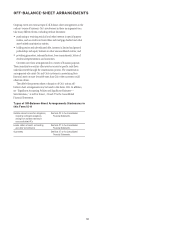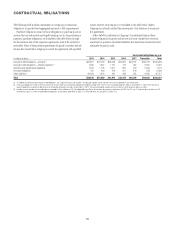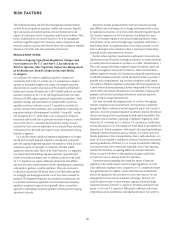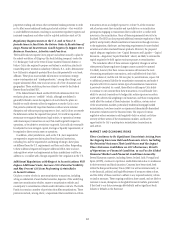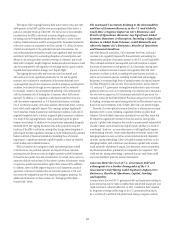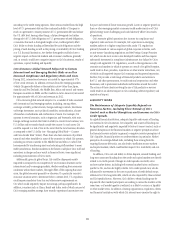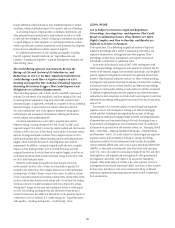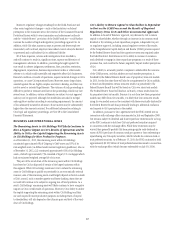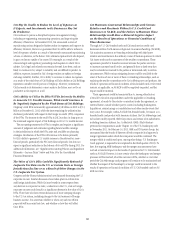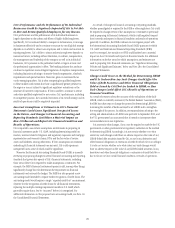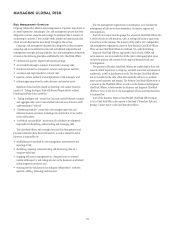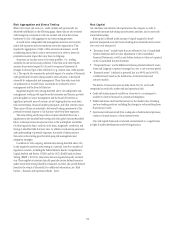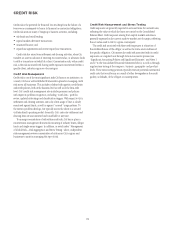Citibank 2012 Annual Report Download - page 89
Download and view the complete annual report
Please find page 89 of the 2012 Citibank annual report below. You can navigate through the pages in the report by either clicking on the pages listed below, or by using the keyword search tool below to find specific information within the annual report.67
Moreover, regulatory changes resulting from the Dodd-Frank Act and
other recent regulatory changes—such as the limitations on federal
preemption in the consumer arena, the creation of the Consumer Financial
Protection Bureau with its own examination and enforcement authority
and the “whistle-blower” provisions of the Dodd-Frank Act—could further
increase the number of legal and regulatory proceedings against Citi. In
addition, while Citi takes numerous steps to prevent and detect employee
misconduct, such as fraud, employee misconduct cannot always be deterred
or prevented and could subject Citi to additional liability.
All of these inquiries, actions and investigations have resulted in,
and will continue to result in, significant time, expense and diversion of
management’s attention. In addition, proceedings brought against Citi
may result in adverse judgments, settlements, fines, penalties, restitution,
disgorgement, injunctions, business improvement orders or other results
adverse to it, which could materially and negatively affect Citi’s businesses,
financial condition or results of operations, require material changes in Citi’s
operations, or cause Citi reputational harm. Moreover, many large claims
asserted against Citi are highly complex and slow to develop, and they may
involve novel or untested legal theories. The outcome of such proceedings is
difficult to predict or estimate until late in the proceedings, which may last
several years. In addition, certain settlements are subject to court approval
and may not be approved. Although Citi establishes accruals for its legal
and regulatory matters according to accounting requirements, the amount
of loss ultimately incurred in relation to those matters may be substantially
higher than the amounts accrued. For additional information relating to
Citi’s legal and regulatory proceedings, see Note 28 to the Consolidated
Financial Statements.
BUSINESS AND OPERATIONAL RISKS
The Remaining Assets in Citi Holdings Will Likely Continue to
Have a Negative Impact on Citi’s Results of Operations and Its
Ability to Utilize the Capital Supporting the Remaining Assets
in Citi Holdings for More Productive Purposes.
As of December 31, 2012, the remaining assets within Citi Holdings
constituted approximately 8% of Citigroup’s GAAP assets and 15% of its
risk-weighted assets (as defined under current regulatory guidelines). Also as
of December 31, 2012, LCL constituted approximately 81% of Citi Holdings
assets, of which approximately 73% consisted of legacy U.S. mortgages which
had an estimated weighted average life of six years.
The pace of the wind-down of the remaining assets within Citi Holdings
has slowed as Citi has disposed of certain of the larger businesses within
this segment. While Citi’s strategy continues to be to reduce the remaining
assets in Citi Holdings as quickly as practicable in an economically rational
manner, sales of the remaining assets could largely depend on factors outside
of Citi’s control, such as market appetite and buyer funding. Assets that are
not sold will continue to be subject to ongoing run-off and paydowns. As a
result, Citi Holdings’ remaining assets will likely continue to have a negative
impact on Citi’s overall results of operations. Moreover, Citi’s ability to utilize
the capital supporting the remaining assets within Citi Holdings and thus
use such capital for more productive purposes, including return of capital
to shareholders, will also depend on the ultimate pace and level of the wind-
down of Citi Holdings.
Citi’s Ability to Return Capital to Shareholders Is Dependent
in Part on the CCAR Process and the Results of Required
Regulatory Stress Tests and Other Governmental Approvals.
In addition to Board of Directors’ approval, any decision by Citi to return
capital to shareholders, whether through an increase in its common stock
dividend or by initiating a share repurchase program, is dependent in part
on regulatory approval, including annual regulatory review of the results
of the Comprehensive Capital Analysis and Review (CCAR) process required
by the Federal Reserve Board and the supervisory stress tests required under
the Dodd-Frank Act. Restrictions on Citi’s ability to increase its common
stock dividend or engage in share repurchase programs as a result of these
processes has, and could in the future, negatively impact market perceptions
of Citi.
Citi’s ability to accurately predict or explain to stakeholders the outcome
of the CCAR process, and thus address any such market perceptions, is
hindered by the Federal Reserve Board’s use of proprietary stress test models.
In 2013, for the first time there will also be a requirement for Citi to publish,
in March and September, certain stress test results (as prescribed by the
Federal Reserve Board) that will be based on Citi’s own stress tests models.
The Federal Reserve Board will disclose, in March, certain results based on
its proprietary stress test models. Because it is not clear how these proprietary
models may differ from Citi’s models, it is likely that Citi’s stress test results
using its own models may not be consistent with those eventually disclosed by
the Federal Reserve Board, thus potentially leading to additional confusion
and impacts to Citi’s perception in the market.
In addition, pursuant to Citi’s agreement with the FDIC entered into in
connection with exchange offers consummated in July and September 2009,
Citi remains subject to dividend and share repurchase restrictions for as long
as the FDIC continues to hold any Citi trust preferred securities acquired
in connection with the exchange offers. While these restrictions may be
waived, they generally prohibit Citi from paying regular cash dividends in
excess of $0.01 per share of common stock per quarter or from redeeming or
repurchasing any Citi equity securities, which includes its common stock or
trust preferred securities. As of February 15, 2013, the FDIC continued to hold
approximately $2.225 billion of trust preferred securities issued in connection
with the exchange offers (which become redeemable on July 30, 2014).



